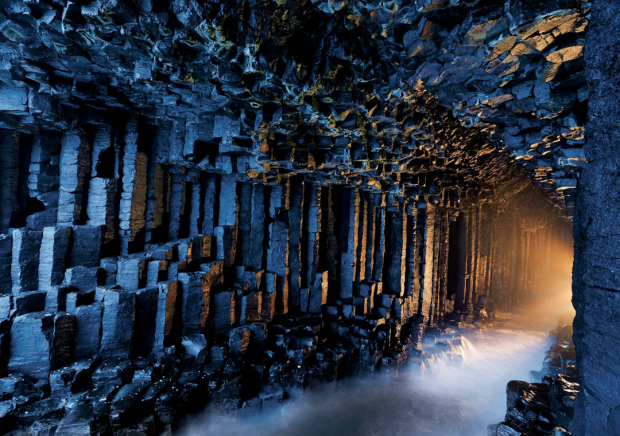Fingal’s Cave, Scotland

Fingal's Cave is a sea cave on the uninhabited island of Staffa, in the Inner Hebrides of Scotland, known for its natural acoustics. The National Trust for Scotland owns the cave as part of a National Nature Reserve.[1] It became known as Fingal's Cave after the eponymous hero of an epic poem by 18th-century Scots poet-historian James Macpherson
Formation[edit]
Fingal's Cave is formed entirely from hexagonally jointed basalt columns within a Paleocene lava flow,[2] similar in structure to theGiant's Causeway in Northern Ireland and those of nearby Ulva.
In all these cases, cooling on the upper and lower surfaces of the solidified lava resulted in contraction and fracturing, starting in a blocky tetragonal pattern and transitioning to a regular hexagonal fracture pattern with fractures perpendicular to the cooling surfaces.[3] As cooling continued these cracks gradually extended toward the centre of the flow, forming the long hexagonal columns we see in the wave-eroded cross-section today. Similar hexagonal fracture patterns are found in desiccation cracks in mud where contraction is due to loss of water instead of cooling
History[edit]
Little is known of the early history of Staffa, although the Swiss town of Stäfa on Lake Zurich was named after the island by a monk from nearbyIona.[6] Part of the Ulva estate of the Clan MacQuarrie from an early date until 1777,[6] the cave was brought to the attention of the English-speaking world by 18th-century naturalist Sir Joseph Banks in 1772.[7][8]
It became known as Fingal's Cave after the eponymous hero of an epic poem by 18th century Scots poet-historian James Macpherson. It formed part of his Ossian cycle of poems claimed to have been based on old Scottish Gaelic poems. In Irish mythology, the hero Fingal is known as Fionn mac Cumhaill, and it is suggested that Macpherson rendered the name as Fingal (meaning "white stranger"[9]) through a misapprehension of the name which in old Gaelic would appear as Finn.[10] The legend of the Giant's Causeway has Fionn or Finn building the causeway between Ireland and Scotland




No comments:
Post a Comment